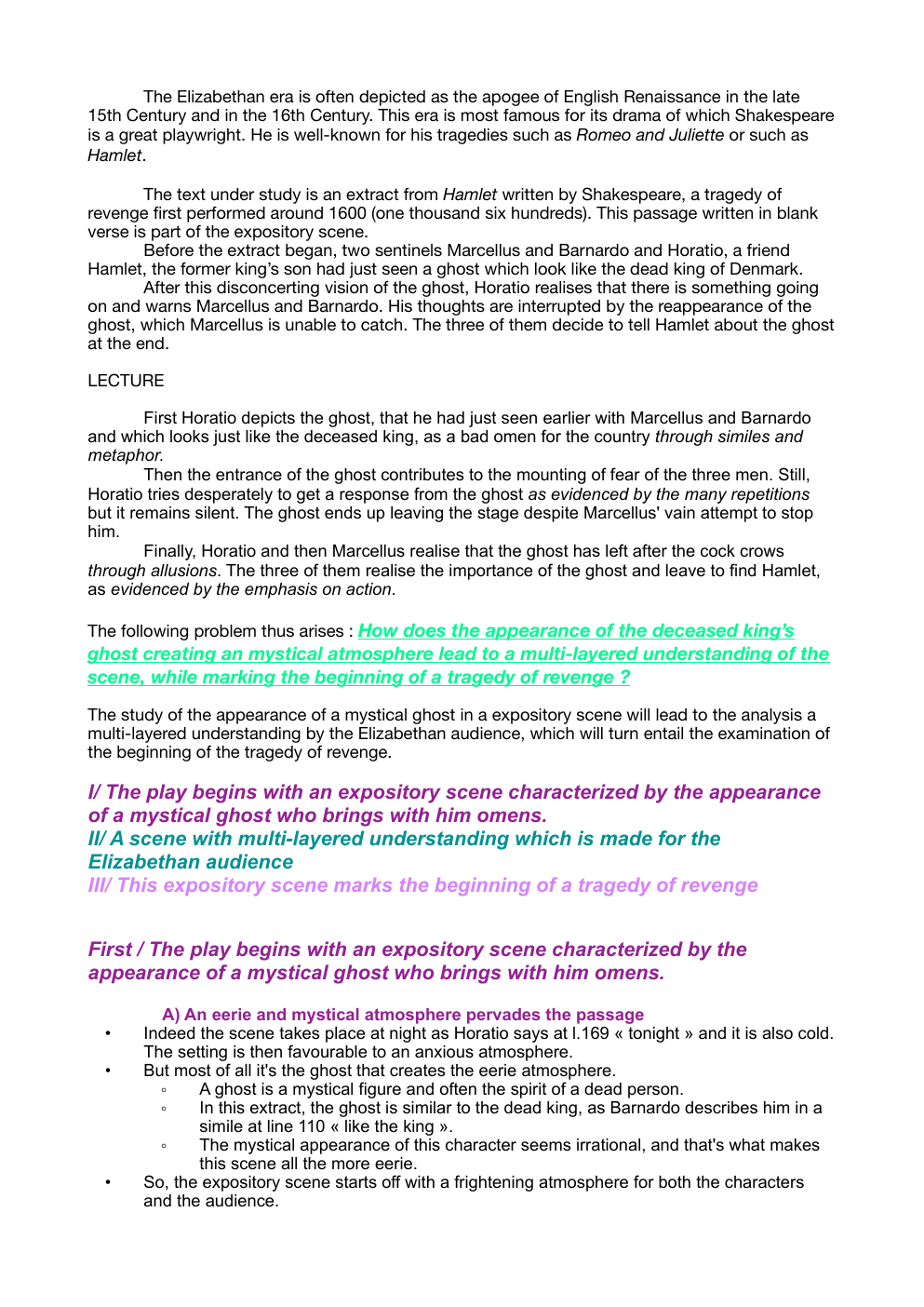Anglais The Elizabethan era
Publié le 18/04/2024
Extrait du document
«
The Elizabethan era is often depicted as the apogee of English Renaissance in the late
15th Century and in the 16th Century.
This era is most famous for its drama of which Shakespeare
is a great playwright.
He is well-known for his tragedies such as Romeo and Juliette or such as
Hamlet.
The text under study is an extract from Hamlet written by Shakespeare, a tragedy of
revenge rst performed around 1600 (one thousand six hundreds).
This passage written in blank
verse is part of the expository scene.
Before the extract began, two sentinels Marcellus and Barnardo and Horatio, a friend
Hamlet, the former king’s son had just seen a ghost which look like the dead king of Denmark.
After this disconcerting vision of the ghost, Horatio realises that there is something going
on and warns Marcellus and Barnardo.
His thoughts are interrupted by the reappearance of the
ghost, which Marcellus is unable to catch.
The three of them decide to tell Hamlet about the ghost
at the end.
LECTURE
First Horatio depicts the ghost, that he had just seen earlier with Marcellus and Barnardo
and which looks just like the deceased king, as a bad omen for the country through similes and
metaphor.
Then the entrance of the ghost contributes to the mounting of fear of the three men.
Still,
Horatio tries desperately to get a response from the ghost as evidenced by the many repetitions
but it remains silent.
The ghost ends up leaving the stage despite Marcellus' vain attempt to stop
him.
Finally, Horatio and then Marcellus realise that the ghost has left after the cock crows
through allusions.
The three of them realise the importance of the ghost and leave to find Hamlet, as evidenced by the emphasis on action. The following problem thus arises : How does the appearance of the deceased king’s ghost creating an mystical atmosphere lead to a multi-layered understanding of the scene, while marking the beginning of a tragedy of revenge ? The study of the appearance of a mystical ghost in a expository scene will lead to the analysis a multi-layered understanding by the Elizabethan audience, which will turn entail the examination of the beginning of the tragedy of revenge. I/ The play begins with an expository scene characterized by the appearance of a mystical ghost who brings with him omens. II/ A scene with multi-layered understanding which is made for the Elizabethan audience III/ This expository scene marks the beginning of a tragedy of revenge First / The play begins with an expository scene characterized by the appearance of a mystical ghost who brings with him omens. • • fi • A) An eerie and mystical atmosphere pervades the passage Indeed the scene takes place at night as Horatio says at l.169 « tonight » and it is also cold. The setting is then favourable to an anxious atmosphere. But most of all it's the ghost that creates the eerie atmosphere. A ghost is a mystical figure and often the spirit of a dead person. ◦ In this extract, the ghost is similar to the dead king, as Barnardo describes him in a ◦ simile at line 110 « like the king ». The mystical appearance of this character seems irrational, and that's what makes ◦ this scene all the more eerie. So, the expository scene starts off with a frightening atmosphere for both the characters and the audience. B) Horatio warns Barnardo and Marcellus that the appearance of the ghost of the former king is a bad omen. • To explain this bad omen, he uses several metaphors with mythological allusions. • From line 113 to 116, Horatio uses Rome as an example. He compares his current situation to Rome through an extended metaphor that ◦ correlates the ghost with « the sheeted deads » at line 115. But it is precisely these « sheeted dead » who, as he says in line 116, « squeak ◦ and gibber in the Roman streets ». • He implies that the ghost they saw could cause the same event. C) The ghost is a source of fear for the characters as evidenced by the anaphoric structures. • When Horatio speaks to the ghost, he is quite frightened, as shown by the break in the iambic pentameter and the repetitions. He says « speak » fives times.... »
↓↓↓ APERÇU DU DOCUMENT ↓↓↓
Liens utiles
- essay anglais: In my opinion, the improvement of human capacities poses several problems
- Anglais leçons: Description Poster The Day After Tomorrow
- LE DISCOURS D’UN ROIFrançais Anglais In the first instance, i’m going to recapitulate the movie for those of you who don’t know.
- Expose anglais: the muslim community in the media
- The HandMaid's tale- Fiche de lecture en Anglais


